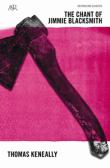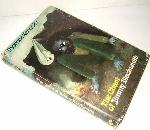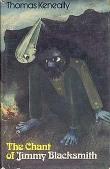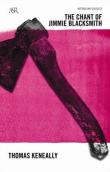AustLit
Latest Issues
AbstractHistoryArchive Description
'When Jimmie Blacksmith marries a white woman, the backlash from both Jimmie's tribe and white society initiates a series of dramatic events. As Jimmie tries to survive between two cultures, tensions reach a head when the Newbys, Jimmie's white employers, try to break up his marriage. The Newby women are murdered and Jimmie flees, pursued by police and vigilantes. The hunt intensifies as further murders are committed, and concludes with tragic results.'
Source: Publisher's blurb (HarperCollins ed.)
Adaptations
-
form
y
 The Chant of Jimmie Blacksmith
( dir. Fred Schepisi
)
Melbourne
:
The Film House
,
1978
Z864554
1978
single work
film/TV
(taught in 3 units)
The Chant of Jimmie Blacksmith
( dir. Fred Schepisi
)
Melbourne
:
The Film House
,
1978
Z864554
1978
single work
film/TV
(taught in 3 units)
Based on real events that occurred in Australia at the turn of the century and adapted from Thomas Keneally's novel, The Chant of Jimmie Blacksmith concerns a young man of Aboriginal and European heritage who has been raised by missionaries. A hard and reliable worker, Jimmie is employed on a property in central-western New South Wales. Hoping to achieve assimiliation into white society, Jimmy marries a white girl, but instead this only increases the loathing and ridicule directed at him. In the winter of 1900, an argument ensues between Jimmy and the owner of the property, which leads to Jimmie and his uncle horrifically killing most of the man's family. Jimmie subsequently takes to the bush with his wife, baby, and younger brother, Mort. Pursued by the police and vigilante farmers, Jimmie sends his wife back with a message: 'tell them I've declared war.' He and Mort kill again, but the younger brother becomes increasingly troubled by their actions. Jimmie eventually goes on alone until his inevitable capture and hanging.
Reading Australia
This work has Reading Australia teaching resources.
Unit Suitable For
AC: Year 11 (Literature Unit 1)
Themes
Aboriginality, Christianity, colonialism, cultural identity, democracy, giving voice to the other, identity, inter-cultural conflict, social identity, violence
General Capabilities
Critical and creative thinking, Ethical understanding, Information and communication technology, Intercultural understanding, Literacy, Personal and social
Notes
-
Dedication: To the Memory of Peter Cady [died] January, 1971.
-
Adapted for the 1978 film The Chant of Jimmie Blacksmith directed by Fred Schepisi. Screenplay by Fred Schepisi.
-
Study guide available.
Publication Details of Only Known VersionEarliest 2 Known Versions of
Other Formats
- Braille.
- Sound recording.
- Large print.
- Dyslexic edition.
Works about this Work
-
y
 Stan Grant on Thomas Keneally
On Thomas Keneally
Carlton
:
Black Inc.
,
2021
20866567
2021
single work
essay
Stan Grant on Thomas Keneally
On Thomas Keneally
Carlton
:
Black Inc.
,
2021
20866567
2021
single work
essay
'Stan Grant is drawn to Thomas Keneally ‘for many reasons: we share an Irish heritage and a complicated relationship with religion. I am especially interested in The Chant of Jimmie Blacksmith, which was a formative novel for me. My family shares a connection with the real Jimmy Governor as well. [The book] raises questions about non-Indigenous writers tackling Indigenous issues and characters.’
'In this eloquent, clear-eyed essay, acclaimed journalist Stan Grant sheds light on one of Australia’s most controversial yet enduringly relevant novels.
'In the Writers on Writers series, leading authors reflect on an Australian writer who has inspired and fascinated them. Provocative and crisp, these books start a fresh conversation between past and present, shed new light on the craft of writing, and introduce some intriguing and talented authors and their work.' (Publication summary)
-
Writing Bennelong : The Cultural Impact of Early Australian Biofictions
2020
single work
criticism
— Appears in: The Journal of Commonwealth Literature , September vol. 55 no. 3 2020; (p. 433–448)'In 1941 Ernestine Hill published My Love Must Wait, a biographical novel based on the life of navigator Matthew Flinders. In the same year, Eleanor Dark published The Timeless Land, imagining the arrival of European settlers in the Sydney region from the perspectives of multiple historical figures. In this article we examine how each author represents the important figure of Bennelong, a man of the Wangal people who was kidnapped by Governor Phillip and who later travelled to England with him. While both works can be criticized as essentialist, paternalist or racist, there are significant differences in the ways each author portrays him. We argue that Dark’s decision to narrate some of her novel from the point of view of Bennelong and other Indigenous people enabled different understandings of Australian history for both historians and fiction writers. Dark’s “imaginative leap”, as critic Tom Griffiths has termed it, catalysed a new way of thinking about the 1788 invasion and early decades of the colonization of Australia. The unfinished cultural work undertaken by these novels continues today, as demonstrated by subsequent Australian novels which revisit encounters between Indigenous inhabitants and European colonists, including Thomas Keneally’s The Chant of Jimmie Blacksmith (1972), Richard Flanagan’s Wanting (2008), and Rohan Wilson’s The Roving Party (2011). Like Dark, these authors situate parts of their novels within the consciousness of Indigenous figures from the historical record. We analyse the diverse challenges and possibilities presented by these literary heirs of Eleanor Dark.' (Publication abstract)
-
Other People's Stories : Reproducing History in 'The Chant of Jimmie Blacksmith'
2020
single work
criticism
— Appears in: Screen Education , no. 96 2020; (p. 124-128)'Fred Schepisi's 'The Chant of Jimmie Blacksmith' (1978), an adaptation of Thomas Keneally's 1972 novel of the same name, is an incendiary film from the Australian New Wave that attempts to give voice to aspects of the nation's violent history. With its then-sizeable A$1.2 million budget, the film was a commercial failure despite playing at the Cannes Film Festival to critical acclaim, and has continued to court controversy.'
Source: Abstract.
-
form
y
 Interviews with 10 Australian Authors
Tom Tilley
(interviewer),
Melbourne
:
ABC Splash
,
2018
16600399
2018
website
interview
film/TV
Interviews with 10 Australian Authors
Tom Tilley
(interviewer),
Melbourne
:
ABC Splash
,
2018
16600399
2018
website
interview
film/TV
'Meet ten of Australia's literary greats. Tom Tilley speaks with writers such as David Malouf, Nadia Wheatley and Michael Gow about their works, their inspirations and their lives as writers.'
Source: Introduction.
-
A Makarrata Declaration : A Declaration of Our Country
2017
single work
essay
— Appears in: The Best Australian Essays 2017 2017; (p. 41-50)'Salman Rushdie — the great Indian writer — once said of the importance of stories: 'Those that do not have the power over the story that dominates their lives, the power to re-tell it, re-think it, deconstruct it, joke about it, and change it as times change, truly are powerless because they cannot think new thoughts.' ' (41)
-
New Novels
1972
single work
review
— Appears in: Overland , Winter no. 52 1972; (p. 52-53)
— Review of The Wire Classroom 1972 single work novel ; The Chant of Jimmie Blacksmith 1972 single work novel ; So Far No Further : A Novel 1971 single work novel -
[Review] The Chant of Jimmie Blacksmith
1972
single work
review
— Appears in: Australian Book Review , September vol. 11 no. 1972; (p. 8-9)
— Review of The Chant of Jimmie Blacksmith 1972 single work novel -
Ignorance and Savagery
1972
single work
review
— Appears in: Hemisphere , October vol. 16 no. 10 1972; (p. 37)
— Review of The Chant of Jimmie Blacksmith 1972 single work novel -
[Review] The Chant of Jimmie Blacksmith
1972
single work
review
— Appears in: The National Times , 17-22 April 1972; (p. 21)
— Review of The Chant of Jimmie Blacksmith 1972 single work novel -
[Review] The Chant of Jimmie Blacksmith
1972
single work
review
— Appears in: Review , 8-14 April 1972; (p. 701)
— Review of The Chant of Jimmie Blacksmith 1972 single work novel -
Thomas Keneally's The Chant of Jimmie Blacksmith and the Palimpsest of Jimmy Governor
2002
single work
criticism
— Appears in: Commonwealth , vol. 25 no. 1 2002; (p. 27-39) Author's abstract : In The Chant of Jimmie Blacksmith, Keneally rewrites the story of the Jimmy Governor murders and manhunt, a significant episode in white/Aboriginal race relations in Australia that took place at the turn of the twentieth century. In his narrative Keneally attempts to eliminate the colonial discourse which underlay contemporary press accounts of the story and to retell it 'objectively', from the enlightened perspective of the 1970s, when white attitudes to Aborigines began to change radically. This article examines and attempts to explain his successes and failures in this under taking. -
Caught Between Two Worlds
2003
single work
column
— Appears in: The Age , 2 April 2003; (p. 7) -
The Borrowers
2003
single work
criticism
— Appears in: The Age , 30 August 2003; (p. 8) -
Keneally and Gare: Boundary Riders and Fringedwellers
1986
single work
criticism
— Appears in: LiNQ , vol. 14 no. 2 1986; (p. 48-56) -
When the Past Is Always Present
2005
single work
essay
— Appears in: The Age , 13 August 2005; (p. 8)
Awards
- 1973 Winner Royal Society of Literature Prize
- 1972 shortlisted The Booker Prize
- 1972 Winner The Sydney Morning Herald Literary Competition
- ca. 1900















